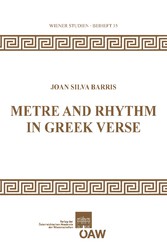Suchen und Finden
Service
Metre and Rhythm in Greek Verse
Joan Silva Barris
Verlag Österreichische Akademie der Wissenschaften Verlag, 2011
ISBN 9783700171560 , 177 Seiten
Format PDF, OL
Kopierschutz DRM
Prologue: Justification and Method (S. 9-10)
In the nineteenth century and at the beginning of the twentieth century, philologists such as Boeckh, Hermann, Westphal, Rossbach, Weil, Masqueray and Blass1, among others, investigated the rhythmic reality hidden behind the syllabic sequences of the Ancient Greek poems. During their time, their works on rhythm gained renown and widespread attention. However, throughout the remainder of the past century, this tendency went into steady disappearance. In fact, extremely authorised voices were raised against the legitimacy of this type of study. Let us take a look, for example, at Paul Maas’ opinion on this subject:
Scarcely any facet of the culture of the ancient world is so alien to us as its quantitative metric. We lack here the most important prerequisite of all historical study; for we can never attain that kind of “empathy” by which all other manifestations of the art, literature, science, philosophy, religion, and social life of the ancients are brought so near to us that they become an essential part of our own culture. This is so because from the first century A.D. onwards the purely quantitative rhythm gradually declined, so that it has now vanished not only from the literature, but from the speech of Europe.
Our feeling for rhythm is altogether dominated by the dynamic rhythm of our own language and metric. This “dynamism” colours also the otherwise quantitative rhythm of our music; and music has a more powerful effect on our emotions than any other form of art. We have no means of reading, reciting, or hearing Greek poetry as it actually sounded. It may be possible for us to form a mental notion of it; but such a mental notion is too shadowy to serve as a basis for the scientific investigation of the subject2. (…)
In a field where almost all that is not trivial is problematic, the reader will hardly expect particular problems to be singled out for mention. Any paragraph of the preceding work, if compared with any other treatment of the same subject, will show only too clearly the difference in the point of view. How, then, is the beginner to distinguish truth from falsehood, or what is profitable from what is not? Music and dancing, the two sister arts of metric, leave us in the lurch; our ear leads us too easily into error.
Thus, since the beginning of the twentieth century, those books devoted to the study of the musical rhythm of ancient poetic texts have created limited resonance4. Similarly, some of the most suggestive rhythmic studies are included within works dedicated to different or broader questions and, as a consequence, are excessively succinct and schematic5. On the other hand, many of the works centering on the detailed study of syllabic sequences are well known – but these do not deal in depth with the correspondence of these sequences to specific musical rhythms.



